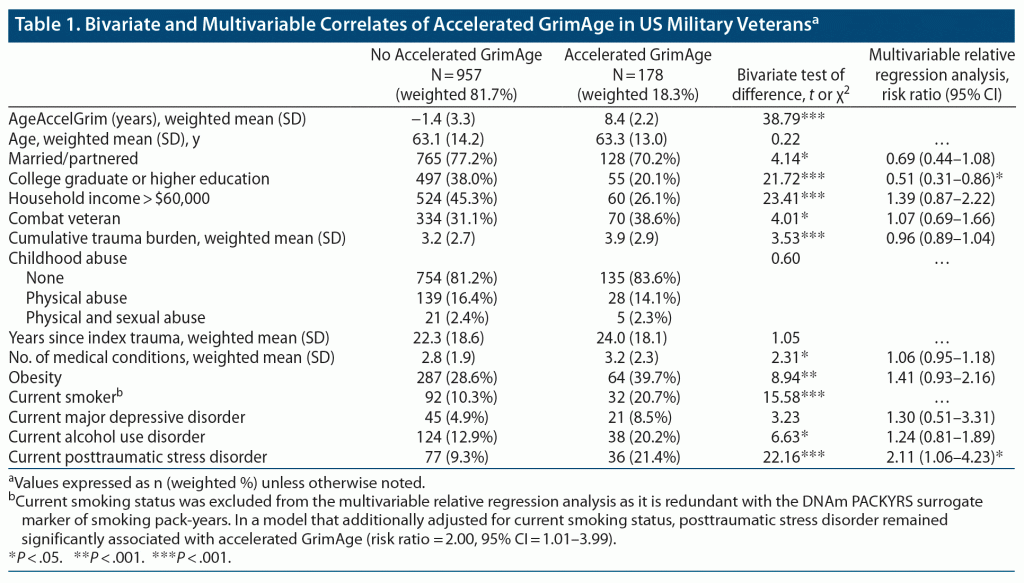
J Clin Psychiatry 2022;83(4):21br14309
To cite: Na PJ, Montalvo-Ortiz JL, Nagamatsu ST, et al. Association of symptoms of posttraumatic stress disorder and GrimAge, an epigenetic marker of mortality risk, in US military veterans. J Clin Psychiatry. 2022;83(4):21br14309.
To share: https://doi.org/10.4088/JCP.21br14309
© 2022 Physicians Postgraduate Press, Inc.
aVA Connecticut Healthcare System, West Haven, Connecticut
bDepartment of Psychiatry, Yale School of Medicine, New Haven, Connecticut
cUS Department of Veterans Affairs National Center for PTSD, VA Connecticut Healthcare System, West Haven, Connecticut
dDepartment of Social and Behavioral Sciences, Yale School of Public Health, New Haven, Connecticut
*Corresponding author: Peter J. Na, MD, MPH, 300 George St, Ste 901, New Haven, CT 06511 ([email protected]).
Posttraumatic stress disorder (PTSD) is prevalent in US military veterans and has been linked to premature mortality, which can be predicted by accelerated epigenetic aging, a marker of biological aging.1
Recent studies have reported associations between PTSD and accelerated epigenetic aging.1 GrimAge, a composite of DNA methylation (DNAm)-based markers linked to health- and lifespan, is the strongest predictor of various age-related metrics (eg, time to death, to coronary heart disease, and to cancer) relative to other measures of epigenetic aging.1 We examined the relationship between PTSD and its specific symptoms, other medical and psychiatric conditions, and GrimAge in a large, nationally representative sample of male US veterans.
METHODS
Participants
The sample included 1,132 male European-American US veterans who participated in the National Health and Resilience in Veterans Study, which surveyed a nationally representative sample of US veterans (see Supplementary Material).
Assessments
GrimAge. GrimAge is a composite measure of epigenetic aging based on 8 DNAm surrogates of plasma proteins that are associated with mortality or morbidity, and a DNAm-based estimator of smoking pack-years. Accelerated GrimAge (ie, greater epigenetic than actual age) was operationalized as a residual GrimAge acceleration ≥ 5 years relative to chronologic age (mean = 8.3 years, standard deviation = 2.2, range = 5–16).
PTSD symptoms. PTSD symptoms were assessed using the PTSD Checklist-Specific Stressor Version (PCL-S); scores ≥ 35 were indicative of probable PTSD.
Methodological details are available in the Supplementary Methods.
Data Analysis
Multivariable relative regression analyses were conducted to examine the relationship between PTSD and accelerated GrimAge (see Supplementary Material).
RESULTS
A total of 18.3% (95% confidence interval [CI] = 16.0%–20.8%) of the sample had accelerated GrimAge. Relative to veterans without accelerated GrimAge, those with accelerated GrimAge were less likely to be married/partnered and to have an annual household income > $60,000/year and more likely to be combat veterans, obese, and current smokers and to screen positive for current alcohol use disorder and PTSD; they also reported more cumulative traumas and medical conditions (Table 1).
When these variables were entered into a relative regression analysis, PTSD was associated with 2-fold greater odds of accelerated GrimAge while college graduate or higher education was associated with lower odds of this outcome; none of the other variables were significant (all P values > 0.20). PTSD remained significantly associated with accelerated GrimAge even after additionally adjusting for smoking status (risk ratio = 2.00, 95% CI = 1.01–3.99).
PTSD was specifically associated with an acceleration in DNAm surrogates of tissue inhibitor metalloproteinase-1 (TIMP-1), β-2 microglobulin (B2M), and growth differentiating factor-15 (GDF-15) (Supplementary Table 1).
Greater severity of trauma-related detachment (ie, feeling distant or cut off from others, OR = 1.73, 95% CI = 1.22–2.45, P = .002; Supplementary Figure 1) and sleep disturbance (OR = 1.51, 95% CI = 1.16–1.95, P = .002) were independently associated with accelerated GrimAge.
DISCUSSION
Results of this nationally representative study of male European-American US veterans revealed that PTSD is associated with 2-fold greater odds of accelerated GrimAge, which averaged nearly a full decade. This association was independent of a broad range of other factors, including smoking.
PTSD was associated with an acceleration in DNAm surrogates of TIMP-1, B2M, and GDF-15. TIMP-1 has been linked to abnormalities in long-term potentiation in the prefrontal cortex2; B2M, with increased stress-induced gene expression in individuals with psychiatric disorders3; and GDF-15, a stress-induced cytokine, with inflammation and physical dysfunction.4
Greater severity of 2 specific PTSD symptoms—detachment and sleep disturbance—were independently associated with accelerated GrimAge. Potential mechanisms linking these particular symptoms to accelerated GrimAge include dysregulation of hypothalamic-pituitary-adrenal axis, neuroendocrine, and inflammatory responses.5,6 While larger and prospective studies are needed to disentangle temporal and mechanistic associations between PTSD and accelerated GrimAge, these findings underscore the utility of transdiagnostic, symptom-level approaches to identifying dimensions of psychopathology linked to epigenetic aging.6
Collectively, the results of this study extend prior work1 to suggest that PTSD is associated with accelerated epigenetic aging in veterans. Limitations of our study include the cross-sectional design; focus on male, European-American veterans, which may limit generalizability of the findings; and use of self-report assessment instruments. Further research is needed to replicate these results in larger, more diverse samples and evaluate the efficacy of interventions for PTSD in forestalling premature biological aging in veterans and other high-risk populations.
Published online: July 6, 2022.
Relevant financial relationships: Dr Gelernter is paid for editorial work on the journal Complex Psychiatry. Dr Krystal is a scientific advisor to Biohaven Pharmaceuticals, BioXcel Therapeutics, Inc., Cadent Therapeutics (Clinical Advisory Board), PsychoGenics, Inc., Stanley Center for Psychiatric research at the Broad Institute of MIT and Harvard, Lohocla Research Corporation. He owns stock and/or stock options in Biohaven Pharmaceuticals, Sage Pharmaceuticals, Spring Care, Inc., BlackThorn Therapeutics, Inc., Terran Biosciences, Inc. He reports income < $10,000 per year from AstraZeneca Pharmaceuticals, Biogen, Idec, MA, Biomedisyn Corporation, Bionomics, Limited (Australia), Boehringer Ingelheim International, Concert Pharmaceuticals, Inc., Epiodyne, Inc., Heptares Therapeutics, Limited (UK), Janssen Research & Development, L.E.K. Consulting, Otsuka America Pharmaceutical, Inc., Perception Neuroscience Holdings, Inc. Spring Care, Inc., Sunovion Pharmaceuticals, Inc., Takeda Industries, and Taisho Pharmaceutical Co., Ltd. He reports income > $10,000 per year from Biological Psychiatry (Editor). Dr Krystal received the drug Saracatinib from AstraZeneca and Mavoglurant from Novartis for research related to National Institute on Alcohol Abuse and Alcoholism grant “Center for Translational Neuroscience of Alcoholism [CTNA-4]” from AstraZeneca Pharmaceuticals. He holds the following patents: (1) Seibyl JP, Krystal JH, Charney DS. Dopamine and Noradrenergic Reuptake Inhibitors in Treatment of Schizophrenia. US Patent #5447948. September 5, 1995; (2) Coric V, Krystal JH, Sanacora G. Glutamate Modulating Agents in the Treatment of Mental Disorders. US Patent #8778979 B2 patent issue date: July 15, 2014. US Patent Application No. 15/695164 filed on 09/05/2017; (3) Charney D, Krystal JH, Manji H, Matthew S, Zarate C. Intranasal Administration of Ketamine to Treat Depression. United States Application No. 14/197767 filed on March 5, 2014; United States application or Patent Cooperation Treaty (PCT) International application No. 14/306382 filed on June 17, 2014; (4) Zarate C, Charney DS, Manji HK, Mathew SJ, Krystal JH, Department of Veterans Affairs “Methods for Treating Suicidal Ideation,” Patent Application No. 14/197.767 filed on March 5, 2014, by Yale University Office of Cooperative Research; (5) Arias A, Petrakis I, Krystal JH. Composition and Methods to Treat Addiction. Provisional Use Patent Application no. 61/973/961. April 2, 2014. Filed by Yale University Office of Cooperative Research; (6) Chekroud A, Gueorguieva R, Krystal JH. Treatment Selection for Major Depressive Disorder filed on June 3, 2016, USPTO docket number Y0087.70116US00. Provisional patent submission by Yale University; (7) Gihyun Y, Petrakis I, Krystal JH—Compounds, Compositions and Methods for Treating or Preventing Depression and Other Diseases. US Provisional Patent Application No. 62/444552, filed on January 10, 2017, by Yale University Office of Cooperative Research OCR 7088 US01; and (8) Abdallah C, Krystal JH, Duman R, Sanacora G. Combination Therapy for Treating or Preventing Depression or Other Mood Diseases. US Provisional Patent Application No. 62/719935 filed on August 20, 2018, by Yale University Office of Cooperative Research OCR 7451 US01. The other authors report no competing interests.
Funding/support: The National Health and Resilience in Veterans Study is supported by the US Department of Veterans Affairs National Center for Posttraumatic Stress Disorder.
Role of the sponsor: The funding agency had no role in the design and conduct of the study; collection, management, analysis, and interpretation of the data; preparation, review, or approval of the manuscript; and decision to submit the manuscript for publication.
Supplementary material: Available at Psychiatrist.com.
References (6)

- Yang R, Wu GWY, Verhoeven JE, et al; PTSD Systems Biology Consortium. A DNA methylation clock associated with age-related illnesses and mortality is accelerated in men with combat PTSD. Mol Psychiatry. 2021;26(9):4999–5009. PubMed CrossRef
- Okulski P, Jay TM, Jaworski J, et al. TIMP-1 abolishes MMP-9-dependent long-lasting long-term potentiation in the prefrontal cortex. Biol Psychiatry. 2007;62(4):359–362. PubMed CrossRef
- Le-Niculescu H, Roseberry K, Levey DF, et al. Towards precision medicine for stress disorders: diagnostic biomarkers and targeted drugs. Mol Psychiatry. 2020;25(5):918–938. PubMed CrossRef
- Tavenier J, Rasmussen LJH, Andersen AL, et al. Association of GDF15 with inflammation and physical function during aging and recovery after acute hospitalization: a longitudinal study of older patients and age-matched controls. J Gerontol A Biol Sci Med Sci. 2021;76(6):964–974. PubMed CrossRef
- Michopoulos V, Powers A, Gillespie CF, et al. Inflammation in fear- and anxiety-based disorders: PTSD, GAD, and beyond. Neuropsychopharmacology. 2017;42(1):254–270. PubMed CrossRef
- McQuaid RJ. Transdiagnostic biomarker approaches to mental health disorders: consideration of symptom complexity, comorbidity and context. Brain Behav Immun Health. 2021;16:100303. PubMed CrossRef
This PDF is free for all visitors!






